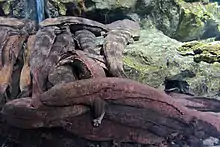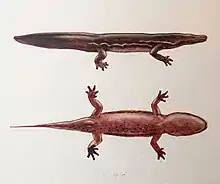Andrias
Andrias is a genus of giant salamanders. It includes the largest salamanders in the world, with A. japonicus reaching a length of 1.44 metres (4 ft 9 in), and A. sligoi reaching 1.80 metres (5 ft 11 in). While extant species are only known from East Asia, several extinct species in the genus are known from fossils collected in Europe and North America, indicating that the genus formerly had a much wider range.[1] One of these, the German A. scheuchzeri, is sometimes considered synonymous with A. davidianus.
| Andrias | |
|---|---|
 | |
| Andrias japonicus | |
| Scientific classification | |
| Kingdom: | Animalia |
| Phylum: | Chordata |
| Class: | Amphibia |
| Order: | Urodela |
| Family: | Cryptobranchidae |
| Genus: | Andrias Tschudi, 1837 |
| Species | |
|
3, see text | |
| Synonyms | |
|
Megalobatrachus | |
Taxonomy
The generic name derives from Ancient Greek ἀνδριάς, "statue." The former name was Megalobatrachus, from Ancient Greek meaning "giant frog."
Species
Extant
| Image | Scientific name | Common Name | Distribution |
|---|---|---|---|
 | Andrias japonicus | Japanese giant salamander | Japan |
 | Andrias davidianus | Chinese giant salamander | China (traditionally considered widespread in the country, but likely restricted to Yangtze River basin) |
 | Andrias sligoi | South China giant salamander | Southern China (Pearl River basin) |
Based on genetic evidence, there may be more extant species in the genus. A study in 2018 found that A. davidianus sensu lato was a species complex that consisted of at least 5 different species.[2] A. sligoi, which was formerly synonymized with A. davidianus, was revived in 2019 for one of these populations.[3]
Extinct
- †Andrias scheuchzeri (Miocene to Pliocene of Germany)
- †Andrias bohemicus (Miocene of the Czech Republic)
- †Andrias matthewi (Miocene of Saskatchewan in Canada and Colorado & Nebraska in the United States)
References
- "Fossilworks: Andrias". fossilworks.org. Retrieved 2018-12-24.
- "5 Giant Salamander Species Identified—And They're All in Danger". National Geographic News. 2018-05-29. Retrieved 2018-12-24.
- Turvey, Samuel T.; Marr, Melissa M.; Barnes, Ian; Brace, Selina; Tapley, Benjamin; Murphy, Robert W.; Zhao, Ermi; Cunningham, Andrew A. (2019). "Historical museum collections clarify the evolutionary history of cryptic species radiation in the world's largest amphibians". Ecology and Evolution. 0 (18): 10070–10084. doi:10.1002/ece3.5257. ISSN 2045-7758. PMC 6787787. PMID 31624538.
- AmphibiaWeb - Andrias japonicus. Accessed 2008-04-08.
- AmphibiaWeb - Andrias davidianus. Accessed 2008-04-08.
- Amphibian Species of the World 5.1. Accessed 2008-04-10.